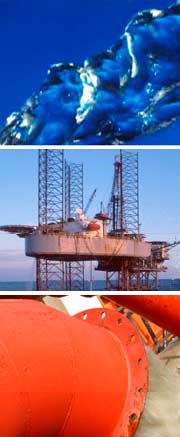  |

The following represents a summary of research and data compiled by Mississippi State University, Agricultural Department regarding bioremediation using Kengro Biosorb.
 |
I. BIOREMEDIATION DEFINED |
|
Bioremediation has been a natural process since the beginning of time. For our purposes, we can define bioremediation as the process by which organic hazardous materials (such as hydrocarbons) are biologically degraded or "broken down", usually into innocuous materials such as carbon dioxide, water inorganic salts and biomass. |
 |
II. REQUIREMENTS |
|
This very simple basic process has few requirements. Assuming nothing has been done to destroy microbial colonies such as excessive heat, certain chemicals or soil sterilization – the key ingredients are:
| 1. |
Microbes – indigenous or supplied |
| 2. |
Available oxygen supply |
| 3. |
Energy source – heat |
| 4. |
Supplemental nutrients – nitrogen, phosphorus, food, and water |
By following simple land-farming techniques, we can greatly enhance the bioremediation process. |
 |
III. APPLICABILITY |
|
Both extensive research and actual field usage has proven a variety of contaminant compounds respond well to bioremediation. Petroleum hydrocarbons are at the top of this list, followed by wood preservants (creosote) and chlorinated solvents.
This process benefits end users in the oilfield, petrochemical refineries, wood processors, and industry in general. It provides one of the most cost-effective ways for waste treatment and significant risk reduction. |
 |
IV. IN SITU (IN PLACE) BIOREMEDIATION USING KENGRO Kengro Biosorb |
|
By treating waste at the spill site, the need for soil removal, transportation, disposal and soil replacement is eliminated. Again, the end user realizes both cost and risk reduction. This process is very effective in the treatment of NONHAZARDOUS OILFIELD WASTE (NOW).
The Environmental Biotechnology Group of the Mississippi Forest Products Laboratory at Mississippi State University has been studying the use of Kengro Biosorb as an oil absorbent and bioremediation enhancer for several years. Their research and actual field usage has proven Kengro Biosorb degradable, high in protein, and contains very large numbers of indigenous microorganisms. It also absorbs up to 12 times its weight in light crude oil, making it the most efficient natural oil absorbent available.
When applied to hydrocarbon-contaminated soil, Kengro Biosorb absorbs more than 55% of the oil in less that 24 hours. In addition, the leaching potential of Kengro Biosorb is extremely low, with only .02% of the oil leaching potential of Kengro Biosorb. The indigenous microbes combined with essential nutrients also found in the core make of Kengro Biosorb very effective in bioremediation. Even at high oil contamination levels, bioremediation was completed in less than nine months.
Using typical land-farming techniques, this process can be completed in as little as 90 days, depending on soil conditions, climate and moisture levels. As stated earlier, a significant reduction in the Total Petroleum Hydrocarbons (TPH) is realized in less than 24 hours, due to the tremendous absorption and holding capacity of Kengro Biosorb. |
 |
V. BASIC PROCEDURE FOR SOIL TREATMENT |
|
| 1. |
Apply Kengro Biosorb evenly across area of contamination; spot treat any pooled oil until completely absorbed. |
| 2. |
Using a rake or rotary tiller, till treated soil to an average depth of 4 to 6 inches. This will incorporate Kengro Biosorb in to the soil as well as provide essential oxygen. |
| 3. |
Monitor soil moisture content at regular intervals, depending of climate. Soil should not be allowed to completely dry out at any time during the process. |
| 4. |
Kengro Biosorb contains essential nutrients, which naturally enhance bioremediation. However, affected soil should be tested to determine the need for additional nutrients or fertilizers. |
| 5. |
For best results, soil pH should remain within 5.5 to 7.0. |
| 6. |
Periodic tilling will insure ample oxygen supply. |
|
 |
VI. FOR SPILLS ON WATER |
|
Kengro Biosorb is hydrophobic and will remain afloat for long periods of time, allowing for easy removal.
When required, set containment booms downstream or along the outer perimeter of spill. Spread Kengro Biosorb manually or mechanically upwind, upstream from spill. Recover using screened forks, skimmers, or vacuum devices. |
to the top |
|





